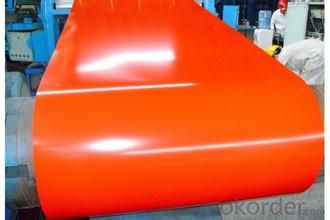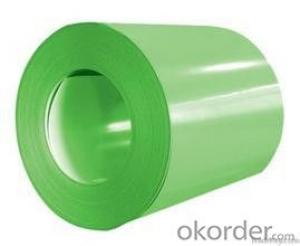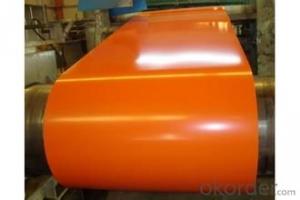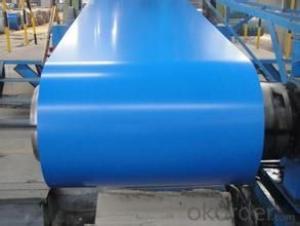Prepainted Galvanized Rolled Steel Coil-DX51D in CNBM
- Loading Port:
- Tianjin
- Payment Terms:
- TT OR LC
- Min Order Qty:
- 30 m.t.
- Supply Capability:
- 500000 m.t./month
OKorder Service Pledge
OKorder Financial Service
You Might Also Like
description
prepainted galvanized steel usually refers to have substrateprocessed with surface processed and coated then(roller coated )or bonded organic thin film and baked, and it is able to be processed tofinal prodevtion .
prepaintedgalvanized steel qualified with excellent decorative ,formability ,corrosionresistance ,coating adhesion ,can keep for a long time as well as maintainfresh color .for color coated steel sheet can obtain good economicbenefit by steel belt wood ,efficient in construction and save energy ,preventpollution etc.which is an ideal material;for manufacturing board.
main features of the galvanized rolled steel
1. low moq: we will do our best to make you satisfied.
2.good service : we treat clients as friend.
3.good quality :we have strict quality control system .good reputation in the market.
4.fast & cheap delivery: we have big discount from forwarder (long contract).
5.supply ability: 50000 ton monthly
specification
yield strength | (mpa) 280-320 |
tensile strength | (mpa) 340-390 |
elongation | 20%-30% |
reverse impact | 9j |
t-bending | ≥2t |
pencil hardness | ≥2h |
duration of salt spray test | 500 h |
bending at 180 degree | no crack, purling and fraction |
image


applications ofprepainted galvanized steel
it can be widely used in transportation, light industry, civil usage and farming. it is also the perfect building material in construction for making steel roofing,insulation panel, corrugate sheet, facade wall,shutters,t-bar and home appliance.
- Q:Apparently, this has to do something with electrochemical cells.
- Steel wood? I don't think there is such a thing?
- Q:What are the different methods of slitting steel coils?
- There are several methods of slitting steel coils, including rotary slitting, wobble slitting, and crush cutting. Rotary slitting involves using circular knives to cut through the steel coil, while wobble slitting uses a wobbling blade that moves from side to side. Crush cutting, on the other hand, involves crushing the steel coil between two rotating blades to create a clean cut. These methods offer different advantages and are chosen based on the specific requirements of the steel coil slitting process.
- Q:How are steel coils used in the production of automotive suspension systems?
- Steel coils are used in the production of automotive suspension systems as they provide the necessary support and flexibility to absorb shocks and vibrations. These coils are typically used in the construction of coil springs, which are then integrated into the suspension system to ensure a smooth and comfortable ride for the vehicle.
- Q:What are the safety precautions while handling steel coils?
- To prevent accidents and injuries when dealing with steel coils, it is crucial to adhere to specific safety measures. Consider the following key precautions: 1. Personal Protective Equipment (PPE): It is essential to wear suitable PPE, including steel-toed boots, safety glasses, gloves, and a hard hat. This protective gear will safeguard against potential hazards like falling objects, sharp edges, and flying debris. 2. Training and Proper Lifting Techniques: Ensure that workers handling steel coils have received thorough training in safe lifting techniques. This involves lifting with the legs, maintaining a straight back, and avoiding twisting motions. By utilizing proper lifting techniques, the risk of back strains and injuries can be minimized. 3. Secure Storage and Stacking: When storing or stacking steel coils, ensure they are placed on a stable and level surface. Employ appropriate storage equipment like racks or pallets to prevent coils from shifting or falling. Stack the coils securely to prevent toppling or collapsing. 4. Inspection and Maintenance: Regularly inspect steel coils for any defects, such as sharp edges, loose bands, or damaged packaging. Avoid handling coils that appear damaged or unstable. Conduct regular maintenance on equipment like forklifts or cranes used for moving the coils to ensure safe operation. 5. Communication and Signaling: Implement clear communication and signaling protocols among workers involved in handling steel coils. This can involve hand signals or radio communication to coordinate movements and prevent accidents, especially in areas with limited visibility. 6. Load Limits and Capacity: Be aware of the load limits and capacity of the equipment used to move steel coils, such as forklifts or cranes. Overloading equipment can lead to instability, tipping, or collapse, thereby increasing the risk of accidents and injuries. 7. Proper Lashing and Securing: When transporting steel coils, employ appropriate lashing and securing methods to prevent movement or falling during transportation. This may entail using straps, chains, or other restraints to keep the coils securely in place. 8. Emergency Preparedness: Establish an emergency plan in case of accidents or injuries. Ensure that workers are trained in first aid and that emergency response equipment, such as fire extinguishers and first aid kits, are easily accessible. By adhering to these safety precautions, the likelihood of accidents and injuries when handling steel coils can be significantly reduced, creating a safer work environment for all individuals involved.
- Q:I don't know it is low alloy steel or high allow steel or medium carbon steel
- Yes,30CrNiMo8 is a high grade alloy steel. *These steels generally contain higher carbon concentration (0.25%). As they are hardenable their mechanical properties can be tailored to specific needs by suitable adjustment of the annealing temperature. Finished products can be hardened to have a high surface hardness in combination with a tough and ductile core. The mechanical properties increase with increasing carbon concentration. Cr and Ni add additional improvements in properties. The Mn grades are a little cheaper. V and Mo add improved temperature resistance. The grades Cxx are developed for less stringent quality requirements but are cheaper.
- Q:What are the different types of steel coil storage systems?
- There are several types of steel coil storage systems, including coil racks, coil cradles, coil saddles, and coil spools. Coil racks are vertical storage systems that allow coils to be stored upright. Coil cradles are horizontal storage systems that support the coil along its length. Coil saddles are similar to cradles but have additional supports to prevent the coil from rolling. Coil spools are specialized storage systems that allow for easy unwinding and rewinding of the coil.
- Q:What are the different methods of testing the mechanical properties of steel coils?
- Testing the mechanical properties of steel coils can be done through various methods, which play a critical role in determining the steel's strength, ductility, and overall quality. Some commonly employed techniques include the following: 1. Tensile testing: This method involves applying a force to a steel coil until it breaks. It measures the maximum stress the material can endure before fracturing, as well as its elongation and reduction in cross-sectional area. Tensile testing provides valuable information about the coil's ultimate tensile strength, yield strength, and elongation. 2. Hardness testing: This test determines a material's resistance to indentation or scratching. Multiple methods, such as Brinell, Vickers, and Rockwell hardness tests, can be employed to measure the hardness of steel coils. These tests offer insights into the steel's ability to resist deformation and wear. 3. Bend testing: Bend testing involves subjecting a steel coil to controlled bending until it reaches a specific angle or a crack appears. This test evaluates the coil's ductility, flexibility, and its resistance to cracking or fracturing under bending stress. 4. Impact testing: Impact testing gauges a steel coil's capacity to absorb energy when exposed to sudden shocks or impacts. The Charpy impact test is the most commonly used method, wherein a notched specimen is struck by a pendulum hammer, and the energy absorbed during fracture is measured. This test assesses the coil's toughness and resistance to brittle fracture. 5. Fatigue testing: Fatigue testing entails subjecting a steel coil to repeated or cyclic loading to simulate the stresses it may experience during its intended use. This test evaluates the coil's ability to withstand repeated stress over an extended period and its resistance to fatigue failure. 6. Ultrasonic testing: Ultrasonic testing utilizes high-frequency sound waves to detect defects or flaws within the steel coil. This non-destructive testing method can identify internal or surface defects like cracks, voids, or inclusions that may impact the steel's mechanical properties. It is worth noting that these testing methods typically adhere to industry standards and specifications, such as those set by ASTM (American Society for Testing and Materials) or ISO (International Organization for Standardization). This ensures the accuracy and reliability of the results obtained.
- Q:is a 1962 steel penny worth anything?
- Don't know that they're worth a whole lot at this time, but hold on to them. They may be at some point, and what's the loss if you keep them? May be worth something to the kids or grandkids?
- Q:What website can I use to find a good picture that shows the atomic structure of a carbon steel?
- You know, I'd have to say it's very complex.
- Q:Is there a chemical that can be applied (spraid, brushed, adhere) to a steel surface to decrease the heat conductive properties of the metal (so it doesn't heat up as quickly)?Thanks in advance!
- There is, but I don't know what it is made out of. It is probably some fireproof, foam material which acts like insulation. I doubt it is designed to resist abrasion however. Most things which adhere to metal surfaces are not flameproof, and those which do resist fire are not good insulators. For example, the ceramic coating of appliances like stoves and washing machines adhere very well and are fire resistant, but do not insulate. It was the failure of the steel insulation which caused the collapse of the world trade centers. The impact of the airplane tore away all the insulation on the supporting struts of the building and then the fire caused the steel to soften and break. Steel was once insulated by wrapping it in asbestos cloth and then applying plaster over this to form a shell. It did not actually adhere to the steel but it did insulate it, and was fireproof. However asbestos is a cancer hazard and a lot of old buildings are being stripped of their asbestos as a safety precaution. The asbestos can be replaced with fiberglass which is usually duct taped together.
1. Manufacturer Overview |
|
|---|---|
| Location | |
| Year Established | |
| Annual Output Value | |
| Main Markets | |
| Company Certifications | |
2. Manufacturer Certificates |
|
|---|---|
| a) Certification Name | |
| Range | |
| Reference | |
| Validity Period | |
3. Manufacturer Capability |
|
|---|---|
| a)Trade Capacity | |
| Nearest Port | |
| Export Percentage | |
| No.of Employees in Trade Department | |
| Language Spoken: | |
| b)Factory Information | |
| Factory Size: | |
| No. of Production Lines | |
| Contract Manufacturing | |
| Product Price Range | |
Send your message to us
Prepainted Galvanized Rolled Steel Coil-DX51D in CNBM
- Loading Port:
- Tianjin
- Payment Terms:
- TT OR LC
- Min Order Qty:
- 30 m.t.
- Supply Capability:
- 500000 m.t./month
OKorder Service Pledge
OKorder Financial Service
Similar products
New products
Hot products
Related keywords































